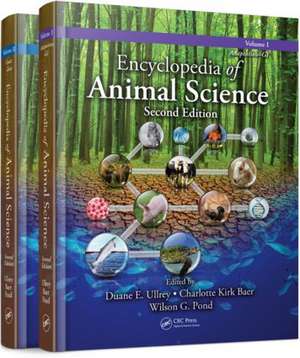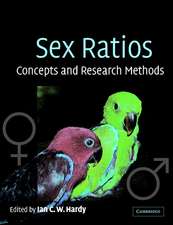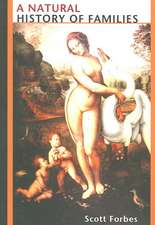Encyclopedia of Animal Science - (Two-Volume Set)
Editat de Duane E. Ullrey, Charlotte Kirk Baer, Wilson G. Ponden Limba Engleză Hardback – feb 2011
PRINT/ONLINE PRICING OPTIONS AVAILABLE UPON REQUEST AT
e-reference@taylorandfrancis.comPreț: 3825.08 lei
Preț vechi: 5128.97 lei
-25% Nou
Puncte Express: 5738
Preț estimativ în valută:
732.16€ • 769.20$ • 615.31£
732.16€ • 769.20$ • 615.31£
Carte tipărită la comandă
Livrare economică 11-25 martie
Preluare comenzi: 021 569.72.76
Specificații
ISBN-13: 9781439809327
ISBN-10: 1439809321
Pagini: 952
Dimensiuni: 210 x 280 x 71 mm
Greutate: 3.49 kg
Ediția:2Revizuită
Editura: CRC Press
Colecția CRC Press
Locul publicării:Boca Raton, United States
ISBN-10: 1439809321
Pagini: 952
Dimensiuni: 210 x 280 x 71 mm
Greutate: 3.49 kg
Ediția:2Revizuită
Editura: CRC Press
Colecția CRC Press
Locul publicării:Boca Raton, United States
Public țintă
ProfessionalRecenzii
“Organized with quick and “reader friendly” descriptions of technologies critical to professionals in animals and food science, food productions and processing, livestock management, and nutrition, … consists of almost 300 entries ranging from adaptation and stress to zoos and aquariums. Enhanced with 100 full color photographs, 2500 references, hundreds of figures, equations and tables, … With examinations of the latest studies on animal genetics, nutrition, lactation, reproductions, as well as animal biodiversity, biotechnology, environmental stability, and more … is an essential core addition to any corporate, academic, or governmental agency Animal Science or Food Safety reference library collection.”
— In Bookwatch, January 2005
“This one volume encyclopedia contains over 300 entries dealing with various aspects of animal science. The focus is on domesticated animals of economic importance, especially ungulates such as cows, goats, horses, and sheep, but also animals such as ratites (ostriches and relatives), mink, catfish, and deer. … The articles also include many entries on non-species based topics such as transgenics, estrous cycles, animal contributions to society, and animal products such as eggs, meat, or hides. There are also articles dealing with specific issues in the care of domesticated animals such as feed, proper housing, antibiotics, and philosophical aspects of animal welfare. The articles are aimed at animal science practitioners and students. Most articles are about 2,000 words long, and summarize the state of the art in the various topics, offering 5-10 citations for further reading and cross-references to other entries. … The encyclopedia is available as print, electronic, and combined products …The encyclopedia will be a good purchase for academic libraries dealing with agriculture, veterinary medicine, or related disciplines. ”
—Diane C. Schmidt, Biology Librarian, University of Illinois at Urbana-Champaign Biology Library, in E-Streams, Vol. 8, No. 8, August 2006
“Reminding us “domestic animals are an integral part of human existence’, this one-of-a-kind resource covers in 300 entries topics ranging from “adaptation and stress” to “zoo animals”. … The esay-long entries re enhanced by hundreds of figures, tables, and color photos.”
— Brian E. Coutts, Professor and Head, Department of Library Public Services , Western Kentucky University; Cheryl LaGuardia is Head, Instructional Services, Harvard College Library; in Library Journal, April 2006
“…a good purchase for academic libraries dealing with agriculture, veterinary medicine, or related disciplines.”
—E-Streams
“…state-of-the-art coverage is given to biotechnology….Bibliographic references to scholarly literature are extensive, and most appear to be up-to-date.”
—Science Books and Films
“…an essential core addition to any corporate, academic, or governmental agency Animal Science or Food Safety reference library collection.”
—The Bookwatch
“…an excellent starting point for information about animal science….highly recommended.”
—Choice
“…an essential, core addition to any corporate, academic, or governmental agency Animal Science or Food Safety reference library collection.”
—Internet Bookwatch
— In Bookwatch, January 2005
“This one volume encyclopedia contains over 300 entries dealing with various aspects of animal science. The focus is on domesticated animals of economic importance, especially ungulates such as cows, goats, horses, and sheep, but also animals such as ratites (ostriches and relatives), mink, catfish, and deer. … The articles also include many entries on non-species based topics such as transgenics, estrous cycles, animal contributions to society, and animal products such as eggs, meat, or hides. There are also articles dealing with specific issues in the care of domesticated animals such as feed, proper housing, antibiotics, and philosophical aspects of animal welfare. The articles are aimed at animal science practitioners and students. Most articles are about 2,000 words long, and summarize the state of the art in the various topics, offering 5-10 citations for further reading and cross-references to other entries. … The encyclopedia is available as print, electronic, and combined products …The encyclopedia will be a good purchase for academic libraries dealing with agriculture, veterinary medicine, or related disciplines. ”
—Diane C. Schmidt, Biology Librarian, University of Illinois at Urbana-Champaign Biology Library, in E-Streams, Vol. 8, No. 8, August 2006
“Reminding us “domestic animals are an integral part of human existence’, this one-of-a-kind resource covers in 300 entries topics ranging from “adaptation and stress” to “zoo animals”. … The esay-long entries re enhanced by hundreds of figures, tables, and color photos.”
— Brian E. Coutts, Professor and Head, Department of Library Public Services , Western Kentucky University; Cheryl LaGuardia is Head, Instructional Services, Harvard College Library; in Library Journal, April 2006
“…a good purchase for academic libraries dealing with agriculture, veterinary medicine, or related disciplines.”
—E-Streams
“…state-of-the-art coverage is given to biotechnology….Bibliographic references to scholarly literature are extensive, and most appear to be up-to-date.”
—Science Books and Films
“…an essential core addition to any corporate, academic, or governmental agency Animal Science or Food Safety reference library collection.”
—The Bookwatch
“…an excellent starting point for information about animal science….highly recommended.”
—Choice
“…an essential, core addition to any corporate, academic, or governmental agency Animal Science or Food Safety reference library collection.”
—Internet Bookwatch
Notă biografică
Duane E. Ullrey, Charlotte Kirk Baer, Wilson G. Pond
Cuprins
Adaptation and Stress: Neuroendocrine, Physiological, and Behavioral Responses; Adaptation and Stress: State of Being; Agroterrorism; Amino Acids: Metabolism and Functions; Amino Acids: Utilization, Gene Expression, and Cell Signaling; Animal Source Foods (ASFs): Improvements; Animal Source Foods (ASFs): Listeria monocytogenes; Animal Source Foods (ASFs): Nutritional Value; Animal Source Foods (ASFs): Quality and Safety of Milk and Eggs; Animal Source Foods (ASFs): Safety of Non-Intact Beef Products; Antibiotics: Microbial Resistance; Antibiotics: Sub-Therapeutic Levels; Antimicrobial Use: Alternatives; Aquaculture; Artificial Insemination; Beef Cattle: Behavior Management and Well-Being; Beef Cattle: Breeds and Genetics; Beef Cattle: Carcass Composition and Quality; Beef Cattle: Crop Residues; Beef Cattle: Crossbreeding; Beef Cattle: Extensive Management; Beef Cattle: Housing; Beef Cattle: Inspection, Processing, and Marketing; Beef Cattle: Intensive Management; Beef Cattle: Manure Management; Beef Cattle: Marketing; Beef Cattle: Nutritional Management; Beef Cattle: Reproduction Management; Beef: Wholesale and Retail; Behavior: Aberrant; Behavior: Feeding; Behavior: Maternal; Behavior: Reproductive; Beta-Adrenergic Agonists; Bioavailability: Amino Acids; Bioavailability: Energy; Bioavailability: Fat-Soluble Vitamins; Bioavailability: Mineral Elements; Bioavailability: Water-Soluble Vitamins; Biodiversity: Germplasm Banks; Biodiversity: Grazing Management; Biofuel By-Products: Use of Glycerol in Ruminants; Biofuel By-Products: Wheat Distillers’ Grain for Cattle; Biomedical Research Models: Contributions to Society; Body Composition: Breed and Species Effects; Body Composition: Chemical Analysis; Body Composition: Genetic Influence; Body Composition: Indirect Measurement; Body Composition: Linear Dimensions; Body Composition: Nutritional Influences; Body Composition: Technical Options for Change; By-Product Feeds: Animal Origin; By-Product Feeds: Plant Origin; By-Products: Biological and Industrial Uses; Camelids; Carcass Composition and Quality: Genetic Influence; Carcass Composition and Quality: Postmortem; Cattle: Embryo Technology; Channel Catfish; Chickens: Behavior Management and Well-Being; Chickens: Broiler Housing; Chickens: Broiler Nutrition Management; Chickens: Broiler Reproduction Management; Chickens: Layer Health Management; Chickens: Layer Housing; Chickens: Layer Nutrition Management; Chickens: Layer Reproduction Management; Cloning by Nuclear Transfer; Colostrum; Companions and Pleasure: Contributions to Society; Conjugated Linoleic Acid; Contributions of Domestic Animals to Society; Crustaceans: Marine Shrimp; Crustaceans: Minor; Cytokine-Induced Hormone Resistance; Dairy Cattle: Behavior Management and State of Being; Dairy Cattle: Breeding and Genetics; Dairy Cattle: Health Management; Dairy Cattle: Nutrition Management; Dairy Cattle: Reproduction Management; Dairy Cattle: Waste Management; Deer and Elk; Digesta Processing and Fermentation; Disease Resistance: Genetics; Diseases: Metabolic Disorders of Ruminants; Domestication; Draft and Transport: Contributions to Society; Ducks: Health Management; Ducks: Nutrition Management; Ecology and Environment; Egg Products: Retail, Catering, and Food Service Products; Eggs: Composition and Structure; Eggs: Industrial Egg Products; Eggs: Marketing; Eggs: Pricing; Eggs: Processing, Inspection, and Grading; Eggs: Shell Egg Products; Embryo Transfer; Environment: Accommodations; Environment: Health Effects; Environmental Pollutants; Estrous Cycle: Cattle, Sheep, and Goat; Estrous Cycle: Mare and Sow; Estrous Synchronization: Cattle; Estrous Synchronization: Horses, Pigs, Sheep, and Goats; Ethanol By-Products: Beef; Ethanol By-Products: Dairy; Farm Animal Welfare: Economic Policies; Farm Animal Welfare: Economics; Farm Animal Welfare: Philosophical Aspects; Feed Quality: External Flow Markers; Feed Quality: Natural Plant Markers: Indigestible Fiber; Feed Quality: Natural Plant Wax Markers; Feed Supplements: Antibiotics; Feed Supplements: Crystalline Vitamins; Feed Supplements: Enzymes, Probiotics, and Yeasts; Feed Supplements: Mineral Salts; Feed Toxicants; Feedstuffs: High-Energy Sources; Feedstuffs: Nonconventional Energy Sources; Feedstuffs: Protein Sources; Feed-to-Food Conversion: Contributions to Society; Female Reproduction: Anatomy and Physiology; Female Reproduction: Endocrine System; Female Reproduction: Maternal–Fetal Relationship; Fertilization; Fiber-Producing Animals; Fishes: Major; Fishes: Minor; Food-Animal Production and Global Change Implications; Forages: Grasses; Forages: Legumes; Forages: Shrubs and Forbs; Functional Amino Acids; Functional Food Components: Eggs from Chickens; Functional Food Components: Ruminant-Derived Foods; Fur and Mink; Future of Animal Agriculture: Demand; Future of Animal Agriculture: Market Strategies; Future of Animal Agriculture: Urban and Rural Agriculture Ecosystems; Geese; Gene Action: Types; Gene Mapping; Genetically Engineered Animals in the Development of Treatments for Human Disease; Genetically Engineered Animals in the Production of Human Pharmaceuticals; Genetically Modified Feeds; Genetically Modified Feeds: Fate of Ingested DNA and Protein; Genetically Modified Feeds: Safety; Genetics: Mendelian; Genetics: Molecular; Genetics: Population; Genetics: Quantitative; Genomic Selection of Phenotype; Genomics; Genotype by Environment (G × E) Interactions; GI Tract: Anatomical and Functional Comparisons; GI Tract: Animal–Microbial Symbiosis; Goat Meat: Carcass Composition and Quality; Goat Milk: Composition and Characteristics; Goat Milk: Quality, Composition, Processing, and Marketing; Goats: Angora; Goats: Behavior, Stress, and Management; Goats: Breeding and Genetics; Goats: Breeds; Goats: Health Management; Goats: Nutrition Management; Grazing Behavior and Nutrient Intake; Grazing Livestock: Vegetation Management; Grazing: Soil Conservation; Greenhouse Gas Emissions; Growth and Development: Avian Embryo; Growth and Development: Cell Differentiation; Growth and Development: Mammalian Fetus; Growth and Development: Peri-Implantation Embryo; Growth and Development: Postnatal; Growth and Development: Pre-Implantation Embryo; Handling: Behavior; Health: Diagnostics; Hormones: Anabolic Agents; Hormones: Protein; Hormones: Steroid; Horses: Behavior Management and Well-Being; Horses: Breeds, Breeding, and Genetics; Horses: Human Interactions; Horses: Nutrition Management; Horses: Reproduction Management; Immune System: Nutrition Effects; Immune System: Stress Effects; Immunity: Acquired; Immunity: Innate; Implantation; International Animal Germplasm Exchange; Kangaroo Harvesting; Lactation: Land Mammal Species Comparisons; Lactation: Marine Mammal Species Comparisons; Lactation: Physiology; Lamb: Carcass Composition and Quality; Lamb: International Marketing; Lamb: United States Marketing; Leptin: Pigs; Leptin: Poultry; Leptin: Ruminants; Lipids; Livestock Breeds; Livestock Programs in Prisons; Lower Digestive Tract Microbiology; Male Reproduction: Physiological Comparisons; Mammals: Carnivores; Mammals: Nonruminant Herbivores; Mammals: Omnivores; Mammals: Ruminants; Mammary Glands: Developmental Changes; Mammary Glands: Hormonal Regulation; Manure Nutrient Management; Manure, Fertilizer, and Fuel in Developed Countries: Contributions to Society; Mathematical Models: Metabolism; Mathematical Models: Population Dynamics; Mathematical Models: Production Systems; Mating Systems; Meat and Poultry: Quality and Safety; Meat Quality: Hydrodynamic Pressure Processing; Meat Quality: Live Evaluation of Cattle; Meat Quality: Visual Appraisal of Carcasses; Metabolic Modifiers; Milk Composition: Species Comparison; Milk Synthesis; Milk Yield Differences; Mineral Elements: Macro; Mineral Elements: Micro (Trace); Mitosis and Meiosis; Mohair: Biology and Characteristics; Mohair: Production and Marketing; Molecular Biology: Animal; Molecular Biology: Microbial; Molluscs; Myostatin: Physiology and Applications; Nutrient Management: Diet Modification; Nutrient Management: Water Quality and Use; Nutrient Requirements: Carnivores; Nutrient Requirements: Nonruminant Herbivores; Nutrient Requirements: Omnivores; Nutrient Requirements: Omnivores: Poultry and Swine; Nutrient Requirements: Ruminants; Nutrients: Digestion and Absorption; Omega-3 and -6 Fatty Acids; Ontogeny: Adipose Tissue; Ontogeny: Muscle; Ontogeny: Skeleton; Parasite and Nutrition Interaction: Nutrition Effects; Parasite and Nutrition Interaction: Parasite Infection Effects; Pathogens: Major Biological Hazards; Pathogens: Sources and Control; Phytases; Placenta: Development; Placenta: Functions; Placenta: Types; Policy Issues: Local and State Land Use Regulation; Policy Issues: Rural and Urban Community Effects; Pork: Carcass Composition and Quality; Pork: Inspection, Processing, and Marketing; Poultry Genetics and Breeding; Poultry Meat: Carcass Composition and Characteristics; Poultry Meat: Inspection and Grading; Poultry Meat: Manure and Wastewater Management; Poultry Meat: Processing; Prawn (Freshwater Shrimp) Culture; Pregnancy: Maternal Response; Pregnancy: Recognition and Signaling; Probiotics; Proteins; Proteins: Oxidation, Turnover, and Proteomics; Quantitative Trait Loci (QTL); Ratites: Biology, Housing, and Management; Ratites: Nutrition Management; Recombinant Bovine Somatotropin: Environmental Impact; Religious Foods: Jewish and Muslim Laws; Rumen Microbiology; Salmon; Selection: Marker Assisted; Selection: Traditional Methods; Sheep Milk and Milk Products: Composition; Sheep Milk and Milk Products: Processing and Marketing; Sheep Reproduction: Accelerated Lambing Systems; Sheep: Breeding and Genetics; Sheep: Health Management; Sheep: Nutrition Management; Sheep: Reproduction Management; Slaughter By-Products: Contributions to Society; Social Ethics; Somatotropin; Sperm Capacitation; Sperm: Sexing; Spermatogenesis, Sperm Transport, and Semen; Stem Cell and Germ Cell Technology; Superovulation; Swine: Behavior Management and Well-Being; Swine: Breeding and Genetics; Swine: Health Management; Swine: Intensive Management Systems; Swine: Product Marketing; Swine: Reproductive Management; Swine: Waste Management; Transgenic Animals; Transgenic Animals: Improved Performance; Transgenic Animals: Mitochondrial Genome Modification; Transgenic Animals: Secreted Products; Transmissible Spongiform Encephalopathies: Biology and Disease; Transmissible Spongiform Encephalopathies: Detection and Diagnosis; Turkeys: Behavior Management and Well-Being; Turkeys: Nutrition Management; Ultrasound Technology: Live Animal and Carcass Evaluation; Vitamin E–Selenium Interrelationship; Vitamins: Fat Soluble; Vitamins: Water Soluble: Biotin, Choline, Niacin, and Ascorbic Acid; Vitamins: Water Soluble: Pantothenic Acid, Folic Acid, and B 12; Vitamins: Water Soluble: Thiamin, Riboflavin, and B 6; Water; Water Buffalo; Water Buffalo: Reproduction Management; Well-Being and Handling; Well-Being Assessment: Behavioral Indicators; Well-Being Assessment: Concepts and Definitions; Well-Being Assessment: Physiological Criteria; Wild Animals in Domestic Environments: Husbandry Considerations; Wool: Biology and Production; Wool: Skirting, Classing, and Marketing; Xenotransplantation; Xenotransplantation: Biological Barriers; Yak; Zeolites: Natural; Zoo Animals
Descriere
Containing case studies that complement material presented in the text, the vast range of this definitive Encyclopediaencompasses animal physiology, animal growth and development, animal behavior, animal reproduction and breeding, alternative approaches to animal maintenance, meat science and muscle biology, farmed animal welfare and bioethics, and food safety. With contributions from top researchers in their discipline, the book addresses new research and advancements in this burgeoning field and provides quick and reader-friendly descriptions of technologies critical to professionals in animal and food science, food production and processing, livestock management, and nutrition.








